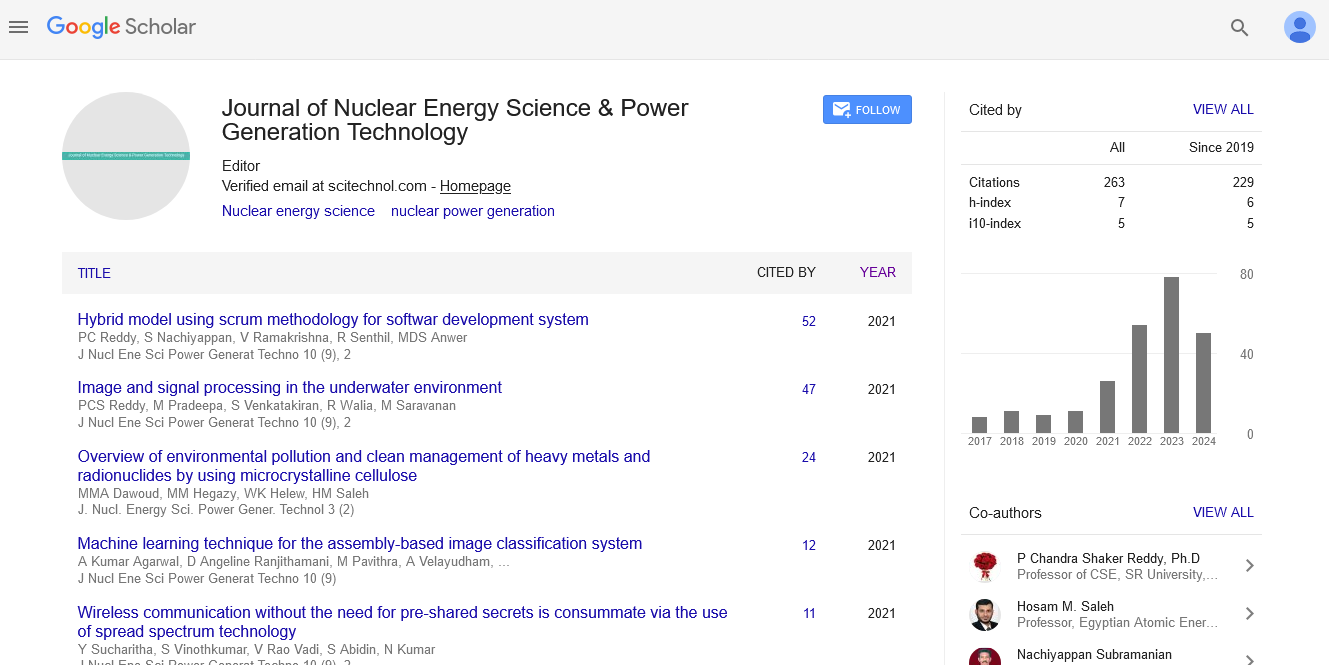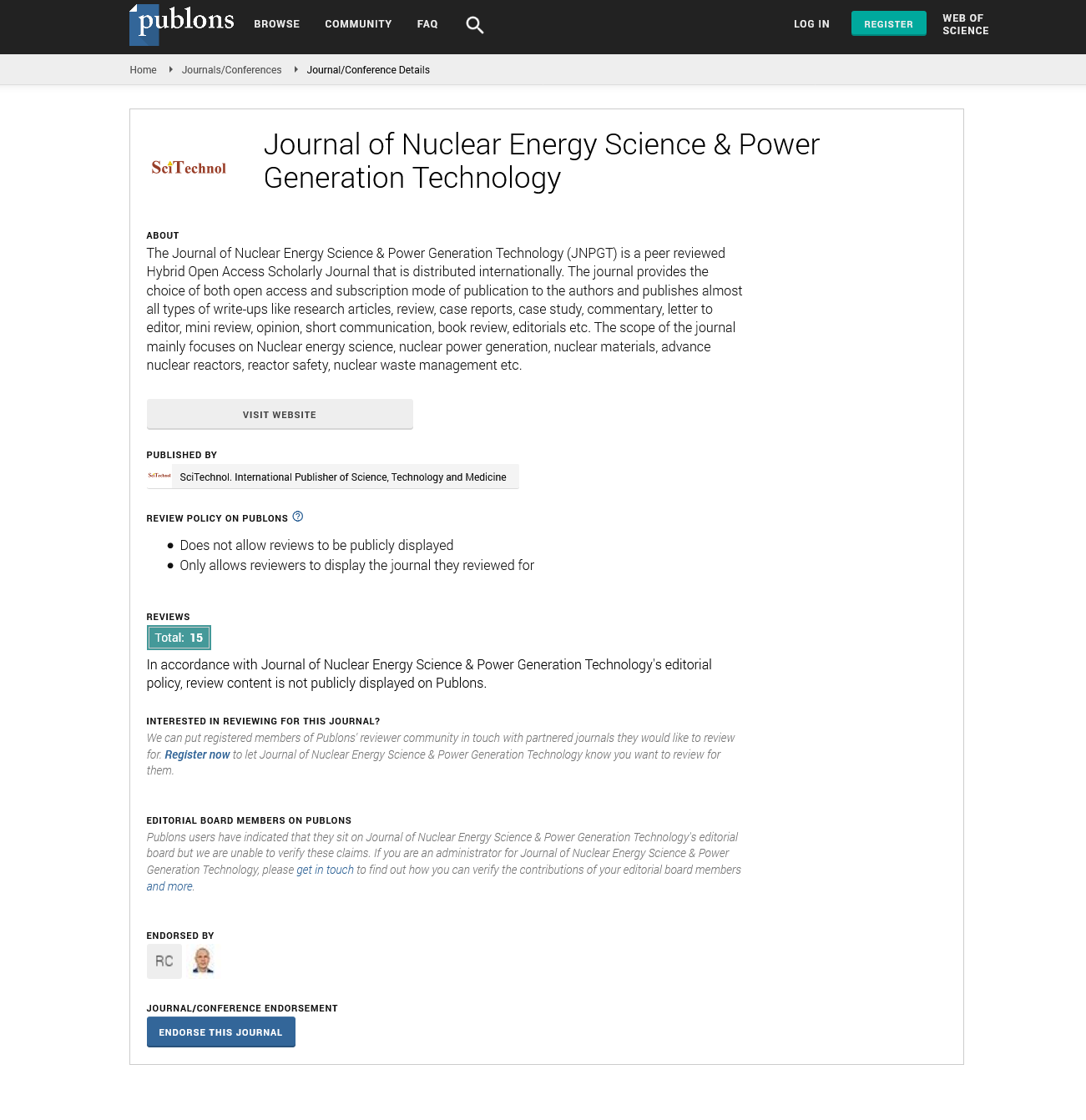Commentary, J Nucl Ene Sci Power Generat Technol Vol: 13 Issue: 6
Innovative Coolant Systems for High-Performance Nuclear Reactors
Juisa Heink*
1Department of Energy Engineering, Kyushu University, Fukuoka, Japan
*Corresponding Author: Juisa Heink,
Department of Energy Engineering, Kyushu
University, Fukuoka, Japan
E-mail: juisa_heink12@gmail.com
Received date: 21 October, 2024, Manuscript No. JNPGT-24-154870;
Editor assigned date: 23 October, 2024, PreQC No. JNPGT-24-154870 (PQ);
Reviewed date: 06 November, 2024, QC No. JNPGT-24-154870;
Revised date: 13 November, 2024, Manuscript No. JNPGT-24-154870 (R);
Published date: 21 November, 2024, DOI: 10.4172/2325-9809.1000424.
Citation: Heink J (2024) Innovative Coolant Systems for High-Performance Nuclear Reactors. J Nucl Ene Sci Power Generat Technol 13:6.
Description
Innovative coolant systems are vital in the design and operation of high-performance nuclear reactors, ensuring not only efficiency but also safety in energy generation. These systems are integral in managing the enormous heat generated during nuclear fission, maintaining the reactor’s structural integrity and preventing overheating that could lead to catastrophic failures. As the demand for cleaner and more sustainable energy sources grows, advancements in coolant technologies are becoming increasingly important to enhance the performance and safety of nuclear reactors. Traditional coolant systems in nuclear reactors typically depend on water due to its effective heat transfer properties, availability and ability to act as a neutron moderator. However, water-based coolants have limitations, particularly in high-temperature environments and in reactors designed for higher efficiency and output. These limitations have increased study into alternative coolant materials and innovative system designs that can operate under extreme conditions while providing superior performance and safety.
One development in this field is the use of liquid metals, such as sodium, lead and their alloys as coolants. Liquid metals have excellent thermal conductivity and can operate at much higher temperatures compared to water enabling higher thermal efficiency in nuclear reactors. For instance, Sodium-Cooled Fast Reactors (SFRs) utilize liquid sodium as a primary coolant, which not only allows for efficient heat transfer but also supports fast neutron spectra, enhancing fuel utilization and reducing nuclear waste. Despite these advantages liquid metal coolants present challenges including chemical reactivity and corrosion issues requiring strong materials and careful engineering solutions. Gas coolants such as helium and carbon dioxide also represent an innovative approach to reactor cooling. Helium, an inert and non-reactive gas is particularly attractive for High-Temperature Gas-Cooled Reactors (HTGRs) due to its chemical stability and high heat capacity. These reactors operate at temperatures exceeding, facilitating direct use of heat for industrial processes or highly efficient electricity generation through Brayton cycle turbines. The development of advanced ceramics and other high-temperature materials is vital to the success of gas-cooled reactor systems, ensuring durability and safety under extreme operating conditions. Molten salt coolants provide another innovative solution for advanced nuclear reactor designs. These salts, in liquid form provide excellent heat transfer capabilities and can operate at low pressures and high temperatures, reducing the risk of pressurized leaks and enabling more compact reactor designs. Molten Salt Reactors (MSRs) can also use the coolant as a solvent for the nuclear fuel itself, producing a unique design where the fuel and coolant are combined. This approach allows for continuous reprocessing of the fuel, enhancing efficiency and reducing long-lived radioactive waste. However, the corrosive nature of molten salts demands the development of corrosion-resistant materials and coatings to ensure the longevity and reliability of reactor components.
Hybrid cooling systems are also emerging as an adaptable solution to see the varying demands of advanced nuclear reactors. By combining multiple cooling methods, such as liquid metal and gas or molten salt and water, hybrid systems aim to control the strengths of each coolant type while mitigating their individual limitations. These systems are particularly beneficial in next-generation reactors designed for diverse applications, ranging from base-load power generation to hydrogen production and space exploration. Innovative coolant systems are not limited to the choice of coolant material they also encompass advancements in system design and operational strategies. Passive cooling systems, for example, rely on natural circulation and gravity determined flows to remove heat, eliminating the need for active pumping mechanisms and improving safety in the event of power loss. These systems are being integrated into advanced reactor designs to provide fail-safe operation and reduce dependence on external power sources.
Conclusion
Digital twin technology and advanced computational modeling are playing an important role in optimizing coolant system performance. By simulating real-time reactor conditions, these technologies allow engineers to predict potential issues before they arise, improving the reliability and efficiency of the cooling systems. Additionally, innovations in materials science such as the development of selfhealing materials and nanostructured coatings, are way for more resilient and long-lasting reactor components. As these innovative systems developed, they ability to make nuclear energy safer, more efficient and better suitable to the challenges of the 21st century, highlighting its role as a basis of a low-carbon energy future
 Spanish
Spanish  Chinese
Chinese  Russian
Russian  German
German  French
French  Japanese
Japanese  Portuguese
Portuguese  Hindi
Hindi 

